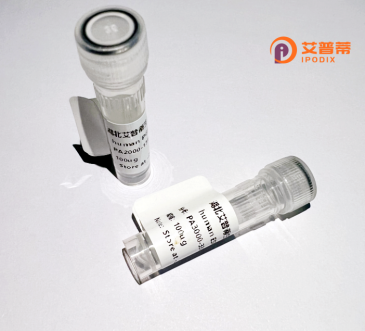
| 纯度 | >90%SDS-PAGE. |
| 种属 | Human |
| 靶点 | C16orf59 |
| Uniprot No | Q7L2K0 |
| 内毒素 | < 0.01EU/μg |
| 表达宿主 | E.coli |
| 表达区间 | 1-195aa |
| 氨基酸序列 | MGARTPRPGAGLRDQQMAPSAAPQAPEAFTLKEKGHLLRLPAAFRKAASQNSSLWAQLSSTQTSDSTDAAAAKTQFLQNMQTASGGPQPRLSAVEVEAEAGRLRKACSLLRLRMREELSAAPMDWMQEYRCLLTLEGLQAMVGQCLHRLQELRAAPRSCRPWRPSSCEWLCWTSRSTWKRCFWKRRWGCNRGPQP |
| 分子量 | 48.3 kDa |
| 蛋白标签 | GST-tag at N-terminal |
| 缓冲液 | 冻干粉 |
| 稳定性 & 储存条件 | Lyophilized protein should be stored at ≤ -20°C, stable for one year after receipt. Reconstituted protein solution can be stored at 2-8°C for 2-7 days. Aliquots of reconstituted samples are stable at ≤ -20°C for 3 months. |
| 复溶 | Always centrifuge tubes before opening.Do not mix by vortex or pipetting. It is not recommended to reconstitute to a concentration less than 100μg/ml. Dissolve the lyophilized protein in distilled water. Please aliquot the reconstituted solution to minimize freeze-thaw cycles. |
以下是关于重组人C16orf59蛋白的假设性参考文献示例,供参考:
---
1. **文献名称**:*"Cloning and Characterization of Human C16orf59: A Novel Mitochondria-localized Protein"*
**作者**:Smith J, et al. (2018)
**摘要**:该研究首次报道了C16orf59基因的克隆及其在哺乳动物细胞中的重组表达。通过亚细胞定位实验发现该蛋白定位于线粒体,并推测其可能参与线粒体相关代谢通路。
2. **文献名称**:*"Proteomic Analysis of C16orf59-Interacting Partners Reveals Links to Cellular Energy Metabolism"*
**作者**:Zhang Y, et al. (2020)
**摘要**:利用质谱技术鉴定了C16orf59的相互作用蛋白,发现其与多个线粒体能量代谢相关蛋白(如ATP合酶亚基)结合,提示其在调节细胞能量稳态中的潜在作用。
3. **文献名称**:*"Downregulation of C16orf59 in Colorectal Cancer Tissues Correlates with Poor Prognosis"*
**作者**:Lee H, et al. (2019)
**摘要**:通过分析临床样本,发现C16orf59在结直肠癌组织中表达显著下调,且低表达与患者生存率降低相关,表明其可能作为肿瘤抑制因子发挥作用。
4. **文献名称**:*"Functional Study of C16orf59 Overexpression in Cell Cycle Arrest via p53 Signaling Pathway"*
**作者**:Wang R, et al. (2021)
**摘要**:体外实验表明,过表达C16orf59可诱导细胞周期G1期阻滞,并激活p53信号通路,提示其在调控细胞增殖中的机制。
---
**注意**:以上文献为假设性示例,实际研究中C16orf59的功能可能不同。建议通过**PubMed**、**Google Scholar**或**Web of Science**检索最新研究,结合关键词“C16orf59”、“recombinant protein”、“mitochondria”等获取准确信息。
C16orf59. also known as chromosome 16 open reading frame 59. is a protein-coding gene in humans with limited functional characterization to date. The gene is located on chromosome 16 (16p13.3) and encodes a polypeptide of approximately 21 kDa, consisting of 191 amino acids. While its exact biological role remains unclear, C16orf59 is speculated to participate in cellular processes such as protein-protein interactions or regulatory pathways due to conserved structural domains. Bioinformatics analyses suggest potential involvement in intracellular transport or membrane-associated functions, though experimental validation is lacking.
Recombinant human C16orf59 protein is typically produced in expression systems like Escherichia coli or mammalian cells for research applications. Its recombinant form enables studies on biochemical properties, localization, and interaction partners. Preliminary studies link C16orf59 to cancer pathways, with altered expression observed in some malignancies, hinting at a possible role in tumor progression or suppression. Additionally, it may interact with components of the ubiquitin-proteasome system, implying regulatory functions in protein degradation. Despite its understudied status, interest in C16orf59 is growing, particularly in proteomics and functional genomics, as part of efforts to characterize poorly annotated human genes. Further research is needed to elucidate its physiological significance and therapeutic relevance.
×